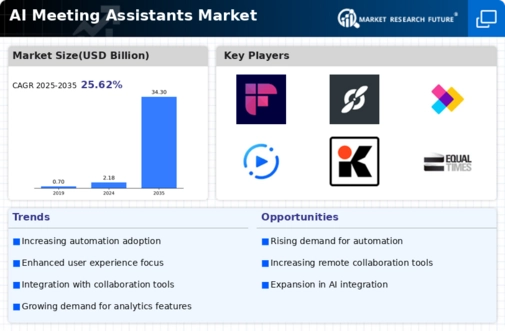Top Industry Leaders in the AI Meeting Assistants Market
Latest Company Updates:
September 2023
Zoom, the video conferencing platform, of late has launched its AI Companion feature and revealed new tools. The company introduced a virtual assistant that allows users to summarize meetings and compose messages. It also released new meeting capabilities to assist before, during, and after video calls. If turned on in Zoom Meetings, participants can use AI Companion to privately chat with the AI and catch up on anything they missed. Once a meeting concludes, the host can create and distribute a meeting summary to attendees or those invited who could not join. The summary recaps the key points using AI.
February 2023
Otter.ai Inc., a popular artificial intelligence meeting transcription app, launched a novel AI-powered meeting assistant which can join meetings & take over the part of taking live notes, including making screen grabs and summarizing key points afterward. The new service, called OtterPilot, essentially “automates meetings from start to finish,” said the company. It works by acting like a studious member of the business who joins the meeting and simply listens to the meeting and automatically gets the job done so that everyone else can pay attention to their own jobs. Otter can be connected to Microsoft or Google calendar for an upcoming meeting and the Otter service will automatically join virtual meetings and begin taking notes. While the meeting is going, attendees can view the live notes as they are being generated, add their own comments, highlight key points and assign action items during the meeting.
Some of AI Meeting Assistants Companies Listed Below:
- Laxis, Inc.
- Fireflies
- Airgram
- Krisp
- Avoma
- tl;dv
- Equal Time
- Rewatch
- Nyota
- Fellow
- Fathom
Strategies Driving Growth:
- Automation and Efficiency: AI assistants automate tasks like note-taking, transcription, and action item generation, freeing up participants to focus on active engagement and critical thinking.
- Meeting Insights and Analytics: AI analyzes meeting content and participant behavior, providing actionable insights, identifying key takeaways, and gauging engagement levels.
- Personalized Meeting Experiences: AI personalizes meeting experiences by adjusting language tone, summarizing key points relevant to individual roles, and providing customized post-meeting follow-up.
- Accessibility and Inclusivity: AI assistants enable real-time translation, transcription, and accessibility features, ensuring participation for those with disabilities or language barriers.
Market Share Decoding: Key Factors to Consider
- Feature Richness and Functionality: Breadth and depth of features, including automation capabilities, analytics tools, and personalization options, influence market share.
- Platform Integration and Interoperability: Seamless integration with existing collaboration tools and workflows enhances user adoption and accessibility.
- Security and Privacy: Robust data security measures and transparent privacy policies are crucial for building trust in sensitive meeting environments.
- Pricing and Licensing Models: Flexible pricing options catering to diverse budgets and deployment needs attract wider customer segments.
New and Emerging Stars: Blazing New Trails
- AI-powered Meeting Companions: Covariant, Humo.ai. These conversational AI assistants go beyond meeting automation, engaging in discussions, answering questions, and facilitating brainstorming sessions.
- Meeting Room Intelligence: Ava, Jabra PanaCast. These intelligent meeting room systems leverage AI to optimize environmental factors like temperature, lighting, and acoustics, enhancing participant comfort and engagement.
- Virtual Reality Meeting Hosts: Spatial.io, Dreamland. VR-powered platforms use AI avatars to host meetings in virtual environments, fostering immersive collaboration and overcoming geographical barriers.
Investment Trends: Where the Money Flows
- Advanced AI Algorithms: Investments are pouring into developing more sophisticated AI algorithms for accurate speech recognition, sentiment analysis, and personalized insights.
- Data Infrastructure and Security: Building robust data infrastructure and ensuring security protocols is critical for handling sensitive meeting content and adhering to privacy regulations.
- User Interface and Design: Companies are investing in intuitive interfaces and user-friendly workflows to simplify engagement with AI features and maximize ease of use.
- Integrations and Partnerships: Strategic partnerships with collaboration platform providers and hardware manufacturers expand market reach and accelerate feature development.









